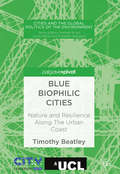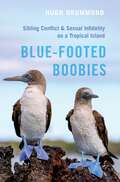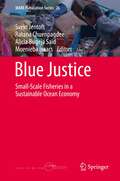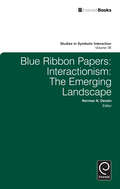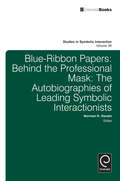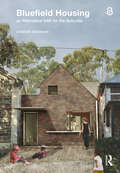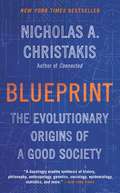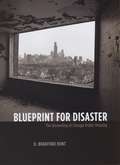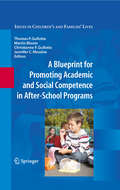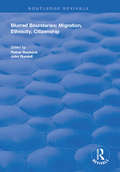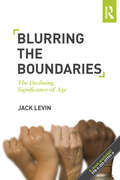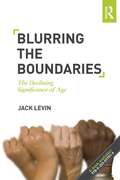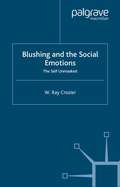- Table View
- List View
Blue and Green Cities: The Role Of Blue-green Infrastructure In Managing Urban Water Resources
by Robert C. BrearsThis book offers new research on urban policy innovations that promote the application of blue-green infrastructure in managing water resources sustainably. The author argues that urban water managers have traditionally relied on grey infrastructural solutions to mitigate risks with numerous economic and environmental consequences. Brears explores the role urban water managers have in implementing blue-green infrastructure to reduce ecological damage and mitigate risk. The case studies in this book illustrate how cities, of differing climates, lifestyles and income-levels, have implemented policy innovations that promote the application of blue-green infrastructure in managing water, wastewater and stormwater sustainably to reduce environmental degradation and enhance resilience to climate change. This new research on urban policy innovations that promote the application of blue-green infrastructure in managing water resources sustainably will be of interest to those working on water conservation and policy.
Blue and Green Cities: The Role of Blue-Green Infrastructure in Managing Urban Water Resources
by Robert C. BrearsA completely revised and updated new edition of this successful book focused on urban policy innovations that promote the application of blue-green infrastructure in managing water resources sustainably. Since the first edition published, nature-based solutions in general and blue-green infrastructure, in particular, have become a more recognised solution to various societal challenges, including mitigating climatic extremes in cities while restoring the natural environment and enhancing biodiversity. This new edition provides updated research on urban policy innovations that promote the application of BGI in managing water resources sustainably. In particular, the book contains case studies that illustrate how cities of differing climates, lifestyles and income levels have implemented policy innovations that promote the application of BGI in managing water, wastewater and stormwater sustainably to enhance resilience to climate change and reduce environmental degradation. The seven case studies are leading cities that have implemented various fiscal and non-fiscal policy tools to encourage the implementation of BGI on both public and private property to reduce stormwater runoff volumes, enhance the health of waterways, enhance resilience to climate change and meet regulatory requirements.
Blue Biophilic Cities: Nature and Resilience Along The Urban Coast
by Timothy BeatleyThere is a growing recognition of the contact we need with nature to be happy, healthy and to lead meaningful lives. We need that nature daily, if not hourly, and so it must be nearby to where we live and work. This is central to the concept of ‘biophilic cities’ which is emerging as a global movement and guiding framework for city design and planning. Blue Biophilic Cities is about the promise of this movement and a kind of biophilic urbanism that is possible for cities perched on the edge of harbours and seas. In blue biophilic cities, much of the nearby nature is to be found in the marine realm. This book explores the efforts underway in a number of cities to foster new marine connections through a variety of innovative programs and initiatives. It also discusses a number of design ideas, from dynamic shoreline edges and floodable parks to living breakwaters, in order to emphasise the possibility of designing for resilience while also supporting marine biodiversity and strengthening biophilic connections to the marine world.
Blue Biophilic Cities: Nature and Resilience Along The Urban Coast
by Timothy BeatleyThere is a growing recognition of the contact we need with nature to be happy, healthy and to lead meaningful lives. We need that nature daily, if not hourly, and so it must be nearby to where we live and work. This is central to the concept of ‘biophilic cities’ which is emerging as a global movement and guiding framework for city design and planning. Blue Biophilic Cities is about the promise of this movement and a kind of biophilic urbanism that is possible for cities perched on the edge of harbours and seas. In blue biophilic cities, much of the nearby nature is to be found in the marine realm. This book explores the efforts underway in a number of cities to foster new marine connections through a variety of innovative programs and initiatives. It also discusses a number of design ideas, from dynamic shoreline edges and floodable parks to living breakwaters, in order to emphasise the possibility of designing for resilience while also supporting marine biodiversity and strengthening biophilic connections to the marine world.
Blue Clay People: Seasons on Africa's Fragile Edge
by William D. Powers"A haunting account of one man's determination and the struggles of a people living in a deeply troubled country."-BooklistWhen William Powers went to Liberia as a fresh-faced aid worker in 1999, he was given the mandate to "fight poverty and save the rainforest." It wasn't long before Powers saw how many obstacles lay in the way, discovering first-hand how Liberia has become a "black hole in the international system"-poor, environmentally looted, scarred by violence, and barely governed. Blue Clay People is an absorbing blend of humor, compassion, and rigorous moral questioning, arguing convincingly that the fate of endangered places such as Liberia must matter to all of us.
Blue-Footed Boobies: Sibling Conflict and Sexual Infidelity on a Tropical Island
by Hugh DrummondIn Blue-Footed Boobies, Hugh Drummond presents a lifetime field study of one of the planet's most charismatic and observable birds, focused on two themes of human relevance: aggressive competition between siblings and monogamous pair-bonding combined with frequent infidelity. In an account peppered with research anecdotes, he immerses readers in a bustling blue-footed booby colony where social manipulation and life-and-death dramas are the stuff of family life. Here, dominant elder chicks prefer to bully their siblings into abject submission rather than killing them and younger siblings' susceptibility to subordination is an evolved ability. The narrative expands to survey the colorful strategies used by young birds and mammals to compete with siblings ruthlessly, with restraint or with courtly manners, scrutinize the role of parents in sibling conflict, and assess the lifetime impacts of bullying on those that survive. Next, a compelling eye-witness account of monogamous partnerships in blue-foots reveals a world disturbingly familiar to humans. After displaying their beauty and physical prowess to each other, females and males select partners and commit to months of relentless parental care, sharing duties and making decisions jointly. Half of them renew their bond the following year, and renewers are more efficient and successful than first-time partners. But colonies of bonded blue-foot pairs are hotbeds of infidelity! Nearly all females and males carry on semi-secret liaisons with 1-3 neighbors, roughly one third of them copulate repeatedly with those extra partners, and one in ten males ends up caring for another male's chick. Countermeasures include surveillance, aggression and partner-switching, and males unsure of paternity sometimes resort to infanticide. Drummond discusses a panoply of plausible biological functions of infidelity. Sibling competition and sexual conflict are widespread in animal species in which two partners raise contemporaneous offspring together, and notorious in humans. In the final chapter Drummond argues for a common evolutionary cause in the blue-foot and human lineages, despite the psychology of their behavior being quite different: whereas boobies thoughtlessly follow routines of predictable actions, humans experience inclinations and urges they can implement in diverse ways, or choose to veto.
Blue-Footed Boobies: Sibling Conflict and Sexual Infidelity on a Tropical Island
by Hugh DrummondIn Blue-Footed Boobies, Hugh Drummond presents a lifetime field study of one of the planet's most charismatic and observable birds, focused on two themes of human relevance: aggressive competition between siblings and monogamous pair-bonding combined with frequent infidelity. In an account peppered with research anecdotes, he immerses readers in a bustling blue-footed booby colony where social manipulation and life-and-death dramas are the stuff of family life. Here, dominant elder chicks prefer to bully their siblings into abject submission rather than killing them and younger siblings' susceptibility to subordination is an evolved ability. The narrative expands to survey the colorful strategies used by young birds and mammals to compete with siblings ruthlessly, with restraint or with courtly manners, scrutinize the role of parents in sibling conflict, and assess the lifetime impacts of bullying on those that survive. Next, a compelling eye-witness account of monogamous partnerships in blue-foots reveals a world disturbingly familiar to humans. After displaying their beauty and physical prowess to each other, females and males select partners and commit to months of relentless parental care, sharing duties and making decisions jointly. Half of them renew their bond the following year, and renewers are more efficient and successful than first-time partners. But colonies of bonded blue-foot pairs are hotbeds of infidelity! Nearly all females and males carry on semi-secret liaisons with 1-3 neighbors, roughly one third of them copulate repeatedly with those extra partners, and one in ten males ends up caring for another male's chick. Countermeasures include surveillance, aggression and partner-switching, and males unsure of paternity sometimes resort to infanticide. Drummond discusses a panoply of plausible biological functions of infidelity. Sibling competition and sexual conflict are widespread in animal species in which two partners raise contemporaneous offspring together, and notorious in humans. In the final chapter Drummond argues for a common evolutionary cause in the blue-foot and human lineages, despite the psychology of their behavior being quite different: whereas boobies thoughtlessly follow routines of predictable actions, humans experience inclinations and urges they can implement in diverse ways, or choose to veto.
Blue Infrastructures: Natural History, Political Ecology and Urban Development in Kolkata (Exploring Urban Change in South Asia)
by Jenia MukherjeeThis book focuses on Kolkata, formerly the colonial capital of and currently a major megacity in India, in terms of its extensive blue infrastructures, i.e., its rivers, canals and wetlands as an integrated composite whole. It unfolds ways in which this reclaimed urban space could determine, and in turn, could get determined by political fate, economic calculations and social livelihoods across changing political-economic imperatives and with large-scale implications on urban sustainability. Employing historical urban political ecology (HUPE) as the methodological framework by combining urban environmental history and urban political ecology, the book studies the changing urban environmental equations through several centuries, and its impact on the city and its people. Weaving the past, present and posterity of deltaic Kolkata, the book demonstrates that it is in these ‘blue infrastructures’ that the anecdote of origin, the account of functioning and the apprehension of survival of the city is rooted. By emphasizing the ecology ‘of’ cities instead of ecology ‘in’ cities approach, the book exposes the limitations of contemporary ecological restructuring efforts regarding Indian cities. Further, it offers a blueprint for future innovative and empirical research focusing on other major cities. Accordingly, this topical and original book will be of interest to students and researchers of environmental humanities, political ecology and urban studies.
Blue Justice: Small-Scale Fisheries in a Sustainable Ocean Economy (MARE Publication Series #26)
by Svein Jentoft Ratana Chuenpagdee Alicia Bugeja-Said Moenieba IsaacsFor small-scale fisheries around the world, the Blue Growth and Blue Economy initiatives may provide sustainable development, but only insofar as they align with the global consensus enshrined in the Voluntary Guidelines for Securing Sustainable Small-Scale Fisheries in the context of Food Security and Poverty Eradication. If states do nothing to fulfill the promises they made when they endorsed these guidelines in 2014, the Blue Economy will come at a loss for small-scale fisheries and further their marginalization in the ocean economy. Under the umbrella of Blue Justice, this book demonstrates that these risks are real and must be considered as states implement their sustainable ocean development plans. These are human rights issues, which are embedded into governance principles and institutions and which make a difference for small-scale fisheries people in their daily lives. In stressing the importance of policies and institutions that build on the experiences of small-scale fisheries people in the contexts in which they operate, this book draws on case studies of small-scale fisheries from countries on all continents to clarify what Blue Justice entails for small-scale fisheries and make suggestions for real change. “Through the Blue Justice paradigm, this book flags the relevance of recognizing the potential impact that different factors, including the Blue Economy approach, could bring to fishing communities, their livelihoods, cultural traditions, and other potential multidimensional conflicts. Vulnerability in fishing communities can increase and inequalities can be reinforced at different levels if individuals and community capabilities are not strengthened… A first of its kind, not to be missed, this book is informative, purposeful, and pertinent in an era of change”. Silvia Salas, CINVESTAV, Marine Resources Department, Mérida, Mexico "The studies reveal that Blue Justice is a ‘governability’ issue, which requires establishing ‘right’ institutions, that are transdisciplinary (integrated), participatory, and holistic. It is implicit from these writings that the SSF Guidelines and Blue Growth initiatives do not form two different discourses, and that the implementation of the former would resolve many of the justice issues caused by the latter, in favor of small-scale fisheries and their communities". Oscar Amarasinghe, Professor & Chancellor, Ocean University of Sri Lanka and President, Sri Lanka Forum for Small Scale Fisheries (SLFSSF)
Blue Ribbon Papers: Interactionism: The Emerging Landscape (Studies in Symbolic Interaction #36)
by Norman K. DenzinVolume 36 of "Studies in Symbolic Interaction" is solely devoted to the "Blue-Ribbon Papers". Nine papers are published in which hotly-contested issues are raised that, even if only resolved partially, could permanently change the future direction of interactional thought. Among the questions addressed are: whether there ever existed a genuine sociological school of thought based on "interactionsim" at the University Chicago, whether Herbert Blumer misinterpreted the major thrust of George Herbert Mead's thought, whether conventional or radical interactionism is the most insightful perspective from which to examine crucial life decisions that are conflict-ridden, whether George Herbert Mead's and George Santayana's perspectives converged with or diverged from one another's and with radical interactionism, whether language develops primarily from the inside out or from the outside in, whether personal economics is mainly responsible for self esteem and the over-all functioning of the self in everyday life, and whether filming constitutes a method of recording data that traditional ethnographers should include in their tool box?
Blue Ribbon Papers: Behind the Professional Mask: The Autobiographies of Leading Symbolic Interactionists (Studies in Symbolic Interaction #38)
by Norman K. Denzin Lonnie Athens"Volume 38 of Studies in Symbolic Interaction" is devoted exclusively to the "Blue Ribbon Papers Series", which is under the intellectual leadership of Lonnie Athens. In this issue, Athens presents the autobiographies of scholars who have made significant contributions to symbolic interactionist approach over the 20th and 21st centuries, including David Altheide, Paul Atkinson, Kathy Chamaraz, Adele Clarke, Gary Cook, Carolyn Ellis, Martyn Hammersley, John Johnson, Joseph Kotarba, and Laurel Richardson. The contributors were all asked to address the question of how they got into their particular fields of study and later became interactionist? They were also prodded to reveal "who is the person behind the professional mask" by describing why and how they changed over the intellectual journeys that they took in becoming some of the best known and well-respected advocates of the symbolic-interactionist's approach in America and Great Britain. These autobiographic reflections and revelations not only shatter the popular stereotype of academics, but also the stereotype of scholars who subscribe to viewpoint of symbolic interactionism.
Bluefield Housing as Alternative Infill for the Suburbs
by Damian MadiganSuburbanised cities share a common dilemma: how to transition to more densely populated and socially connected urban systems while retaining low-rise character, avoiding gentrification, and opening neighbourhoods to more diverse housing choices. Bluefield Housing offers a new land definition and co-located infill model addressing these concerns, through describing and deploying the types of ad-hoc modifications that have been undertaken in the suburbs for decades. Extending green-, brown-, and greyfield definitions, it provides a necessary middle ground between the ‘do nothing’ attitude of suburban preservation and the ‘do everything’ approach of knock-down-rebuild regeneration.An adjunct to ‘missing middle’ and subdivision densification models, with a focus on co-locating homes on small lots, Bluefield Housing presents a unified design approach to suburban infill: retrofitting original houses, retaining and enhancing landscape and urban tree canopies, and delivering additional homes as low-rise additions and backyard homes suited to the increasingly complex make-up of our households.Extensively illustrated by the author with engaging architectural design studies, Damian Madigan describes how existing quirks of suburban housing can prompt new forms of infill, explains why a new suburban densification model is not only necessary but can be made desirable for varied stakeholders, and charts a path towards the types of statutory and market triggers required to make bluefield housing achievable. Using Australian housing as an example but addressing universal concerns around neighbourhood character, demographic needs, housing diversity, dwelling flexibility, and landscape amenity, Bluefield Housing offers innovative suburban infill ideas for policy makers, planners, architects, researchers and students of housing and design studies, and for those with a stake in the future of the suburbs.The Open Access version of this book, available at www.taylorfrancis.com, has been made available under a Creative Commons Attribution-Non Commercial-No Derivatives (CC-BY-NC-ND) 4.0 license.
Bluefield Housing as Alternative Infill for the Suburbs
by Damian MadiganSuburbanised cities share a common dilemma: how to transition to more densely populated and socially connected urban systems while retaining low-rise character, avoiding gentrification, and opening neighbourhoods to more diverse housing choices. Bluefield Housing offers a new land definition and co-located infill model addressing these concerns, through describing and deploying the types of ad-hoc modifications that have been undertaken in the suburbs for decades. Extending green-, brown-, and greyfield definitions, it provides a necessary middle ground between the ‘do nothing’ attitude of suburban preservation and the ‘do everything’ approach of knock-down-rebuild regeneration.An adjunct to ‘missing middle’ and subdivision densification models, with a focus on co-locating homes on small lots, Bluefield Housing presents a unified design approach to suburban infill: retrofitting original houses, retaining and enhancing landscape and urban tree canopies, and delivering additional homes as low-rise additions and backyard homes suited to the increasingly complex make-up of our households.Extensively illustrated by the author with engaging architectural design studies, Damian Madigan describes how existing quirks of suburban housing can prompt new forms of infill, explains why a new suburban densification model is not only necessary but can be made desirable for varied stakeholders, and charts a path towards the types of statutory and market triggers required to make bluefield housing achievable. Using Australian housing as an example but addressing universal concerns around neighbourhood character, demographic needs, housing diversity, dwelling flexibility, and landscape amenity, Bluefield Housing offers innovative suburban infill ideas for policy makers, planners, architects, researchers and students of housing and design studies, and for those with a stake in the future of the suburbs.The Open Access version of this book, available at www.taylorfrancis.com, has been made available under a Creative Commons Attribution-Non Commercial-No Derivatives (CC-BY-NC-ND) 4.0 license.
Blueprint: The Evolutionary Origins of a Good Society
by Nicholas A. Christakis"A dazzlingly erudite synthesis of history, philosophy, anthropology, genetics, sociology, economics, epidemiology, statistics, and more" (Frank Bruni, The New York Times), Blueprint shows why evolution has placed us on a humane path -- and how we are united by our common humanity.For too long, scientists have focused on the dark side of our biological heritage: our capacity for aggression, cruelty, prejudice, and self-interest. But natural selection has given us a suite of beneficial social features, including our capacity for love, friendship, cooperation, and learning. Beneath all of our inventions -- our tools, farms, machines, cities, nations -- we carry with us innate proclivities to make a good society.In Blueprint, Nicholas A. Christakis introduces the compelling idea that our genes affect not only our bodies and behaviors, but also the ways in which we make societies, ones that are surprisingly similar worldwide.With many vivid examples -- including diverse historical and contemporary cultures, communities formed in the wake of shipwrecks, commune dwellers seeking utopia, online groups thrown together by design or involving artificially intelligent bots, and even the tender and complex social arrangements of elephants and dolphins that so resemble our own -- Christakis shows that, despite a human history replete with violence, we cannot escape our social blueprint for goodness.In a world of increasing political and economic polarization, it's tempting to ignore the positive role of our evolutionary past. But by exploring the ancient roots of goodness in civilization, Blueprint shows that our genes have shaped societies for our welfare and that, in a feedback loop stretching back many thousands of years, societies are still shaping our genes today.
Blueprint: The Evolutionary Origins of a Good Society
by Nicholas A. Christakis"A dazzlingly erudite synthesis of history, philosophy, anthropology, genetics, sociology, economics, epidemiology, statistics, and more" (Frank Bruni, The New York Times), Blueprint shows why evolution has placed us on a humane path -- and how we are united by our common humanity.For too long, scientists have focused on the dark side of our biological heritage: our capacity for aggression, cruelty, prejudice, and self-interest. But natural selection has given us a suite of beneficial social features, including our capacity for love, friendship, cooperation, and learning. Beneath all of our inventions -- our tools, farms, machines, cities, nations -- we carry with us innate proclivities to make a good society.In Blueprint, Nicholas A. Christakis introduces the compelling idea that our genes affect not only our bodies and behaviors, but also the ways in which we make societies, ones that are surprisingly similar worldwide.With many vivid examples -- including diverse historical and contemporary cultures, communities formed in the wake of shipwrecks, commune dwellers seeking utopia, online groups thrown together by design or involving artificially intelligent bots, and even the tender and complex social arrangements of elephants and dolphins that so resemble our own -- Christakis shows that, despite a human history replete with violence, we cannot escape our social blueprint for goodness.In a world of increasing political and economic polarization, it's tempting to ignore the positive role of our evolutionary past. But by exploring the ancient roots of goodness in civilization, Blueprint shows that our genes have shaped societies for our welfare and that, in a feedback loop stretching back many thousands of years, societies are still shaping our genes today.
Blueprint for Disaster: The Unraveling of Chicago Public Housing (Historical Studies of Urban America)
by D. Bradford HuntNow considered a dysfunctional mess, Chicago’s public housing projects once had long waiting lists of would-be residents hoping to leave the slums behind. So what went wrong? To answer this complicated question, D. Bradford Hunt traces public housing’s history in Chicago from its New Deal roots through current mayor Richard M. Daley’s Plan for Transformation. In the process, he chronicles the Chicago Housing Authority’s own transformation from the city’s most progressive government agency to its largest slumlord. Challenging explanations that attribute the projects’ decline primarily to racial discrimination and real estate interests, Hunt argues that well-intentioned but misguided policy decisions—ranging from design choices to maintenance contracts—also paved the road to failure. Moreover, administrators who fully understood the potential drawbacks did not try to halt such deeply flawed projects as Cabrini-Green and the Robert Taylor Homes. These massive high-rise complexes housed unprecedented numbers of children but relatively few adults, engendering disorder that pushed out the working class and, consequently, the rents needed to maintain the buildings. The resulting combination of fiscal crisis, managerial incompetence, and social unrest plunged the CHA into a quagmire from which it is still struggling to emerge. Blueprint for Disaster, then,is an urgent reminder of the havoc poorly conceived policy can wreak on our most vulnerable citizens.
Blueprint for Disaster: The Unraveling of Chicago Public Housing (Historical Studies of Urban America)
by D. Bradford HuntNow considered a dysfunctional mess, Chicago’s public housing projects once had long waiting lists of would-be residents hoping to leave the slums behind. So what went wrong? To answer this complicated question, D. Bradford Hunt traces public housing’s history in Chicago from its New Deal roots through current mayor Richard M. Daley’s Plan for Transformation. In the process, he chronicles the Chicago Housing Authority’s own transformation from the city’s most progressive government agency to its largest slumlord. Challenging explanations that attribute the projects’ decline primarily to racial discrimination and real estate interests, Hunt argues that well-intentioned but misguided policy decisions—ranging from design choices to maintenance contracts—also paved the road to failure. Moreover, administrators who fully understood the potential drawbacks did not try to halt such deeply flawed projects as Cabrini-Green and the Robert Taylor Homes. These massive high-rise complexes housed unprecedented numbers of children but relatively few adults, engendering disorder that pushed out the working class and, consequently, the rents needed to maintain the buildings. The resulting combination of fiscal crisis, managerial incompetence, and social unrest plunged the CHA into a quagmire from which it is still struggling to emerge. Blueprint for Disaster, then,is an urgent reminder of the havoc poorly conceived policy can wreak on our most vulnerable citizens.
Blueprint for Disaster: The Unraveling of Chicago Public Housing (Historical Studies of Urban America)
by D. Bradford HuntNow considered a dysfunctional mess, Chicago’s public housing projects once had long waiting lists of would-be residents hoping to leave the slums behind. So what went wrong? To answer this complicated question, D. Bradford Hunt traces public housing’s history in Chicago from its New Deal roots through current mayor Richard M. Daley’s Plan for Transformation. In the process, he chronicles the Chicago Housing Authority’s own transformation from the city’s most progressive government agency to its largest slumlord. Challenging explanations that attribute the projects’ decline primarily to racial discrimination and real estate interests, Hunt argues that well-intentioned but misguided policy decisions—ranging from design choices to maintenance contracts—also paved the road to failure. Moreover, administrators who fully understood the potential drawbacks did not try to halt such deeply flawed projects as Cabrini-Green and the Robert Taylor Homes. These massive high-rise complexes housed unprecedented numbers of children but relatively few adults, engendering disorder that pushed out the working class and, consequently, the rents needed to maintain the buildings. The resulting combination of fiscal crisis, managerial incompetence, and social unrest plunged the CHA into a quagmire from which it is still struggling to emerge. Blueprint for Disaster, then,is an urgent reminder of the havoc poorly conceived policy can wreak on our most vulnerable citizens.
A Blueprint for Promoting Academic and Social Competence in After-School Programs (Issues in Children's and Families' Lives #10)
by Thomas P. Gullotta Martin Bloom Jennifer C. Messina Christianne F. GullottaSchool activities alone are not always sufficient to ensure children’s academic progress or socio-emotional development and well-being. And the time when many children typically have the least adult supervision – immediately after school – is also the time that they are at the highest risk to act as perpetrators or become victims of antisocial behavior. Throughout A Blueprint for Promoting Academic and Social Competence in After-School Programs, which focuses on children in grades 1 through 6, noted experts identify the best practices of effective programs and pinpoint methods for enhancing school-based skills and making them portable to home and neighborhood settings. This volume: (1) Analyzes the concepts central to effective after-school programs. (2) Offers developmental, cognitive, and social ecology perspectives on how children learn. (3) Features more than 100 exercises that develop young people’s capabilities for academic, social, moral, and emotional learning – These exercises are ready to use or can be adapted to students’ unique needs. (4) Emphasizes young people’s development as students and as productive members of society during middle to late childhood and early adolescence. (5) Presents explicit theory and evidence that can be used to explain the value of after-school programs for budget proposals. This important book will find an appreciative, ready audience among the program directors who design after-school curricula, the educators who implement them, the mental health and social work professionals who help staff them, and the current crop of graduate students who will create the next generation of programs.
Blurred Boundaries: Migration, Ethnicity, Citizenship (Routledge Revivals)
by Rainer Bauböck John RundellFirst published in 1999, this volume examines new forms of cultural diversity which result from migration and globalization. Historically, most liberal democracies have developed on the basis of national cultures – either a single one, or a dominant one, or a federation of several ones. However, political and economic developments have upset traditional patterns and have blurred established boundaries. Ongoing immigration from diverse origins has inserted new ethnic minorities into formerly homogenous populations. Democratic liberties and rights provided opportunities for old and new marginalized minorities to resist assimilation and to assert identities. The resulting pattern of multiculturalism is different from earlier ones. Often cultural boundaries are neither clearly defined nor do they simply dissolve by assimilation into a dominant group – they have become fuzzy and a constant source of real or imagined hostility and anxiety. A proliferation of mixed identities goes together with stronger claims for cultural rights and escalating hostilities between ethnic minorities and national majorities. In many countries multiculturalism is today perceived as a challenge rather than as an enrichment. The book focuses on the question how institution and policies of liberal democracies can cope with these trends. The book addresses two tasks: 1) To compare different national contexts and types of ethnic groups (immigrant and indigenous, linguistic and religious minorities) and to discuss how policies of multicultural integration have to be adapted in order to cope with such differences. 2) To evaluate the impact of common rends of globalization which link societies and encourage convergence between national models of multicultural integration.
Blurred Boundaries: Migration, Ethnicity, Citizenship (Routledge Revivals)
by Rainer Bauböck and John RundellFirst published in 1999, this volume examines new forms of cultural diversity which result from migration and globalization. Historically, most liberal democracies have developed on the basis of national cultures – either a single one, or a dominant one, or a federation of several ones. However, political and economic developments have upset traditional patterns and have blurred established boundaries. Ongoing immigration from diverse origins has inserted new ethnic minorities into formerly homogenous populations. Democratic liberties and rights provided opportunities for old and new marginalized minorities to resist assimilation and to assert identities. The resulting pattern of multiculturalism is different from earlier ones. Often cultural boundaries are neither clearly defined nor do they simply dissolve by assimilation into a dominant group – they have become fuzzy and a constant source of real or imagined hostility and anxiety. A proliferation of mixed identities goes together with stronger claims for cultural rights and escalating hostilities between ethnic minorities and national majorities. In many countries multiculturalism is today perceived as a challenge rather than as an enrichment. The book focuses on the question how institution and policies of liberal democracies can cope with these trends. The book addresses two tasks: 1) To compare different national contexts and types of ethnic groups (immigrant and indigenous, linguistic and religious minorities) and to discuss how policies of multicultural integration have to be adapted in order to cope with such differences. 2) To evaluate the impact of common rends of globalization which link societies and encourage convergence between national models of multicultural integration.
Blurring The Boundaries: The Declining Significance of Age
by Jack LevinOver the decades, the lines separating young- middle-aged-, and older adults have blurred, as indicated by a broadening of the appropriate years for making life decisions. Not only are many people marrying later, but some are marrying earlier than ever. Overall, women giving birth later, but some are having children earlier in their lives. Older people are retiring later, but some are retiring at a younger age. The spread or variability (standard deviation) of age-based decisions has increased substantially, giving adults greater freedom from the traditional constraints of age. With these relaxed age norms has come a host of related social problems. The relaxation of age norms for adult decision-making has inadvertently blurred the boundaries between adults and teenagers, between teenagers and children. This generalization of the phenomenon throughout the life cycle is responsible for the adultification of childhood. Eight year old girls are, to an increasing extent, being treated as sexual objects; bullying peaks in the 6th grade; larger numbers of girls are having oral sex or sexual intercourse by the age of 15; the pregnancy rate for girls 13-15 is on the rise; we are in the process of dismantling the juvenile justice system in favor of adult forms of punishment; and more and more children are left without adult supervision in the afternoons, as though they were miniature adults who are capable of raising themselves. Jack Levin is the American Sociological Association’s 2009 Winner of the “Public Understanding of Sociology” Award. This short book communicates the power and importance of sociological thinking to major, worldwide social trends. Ideal for use in undergraduate courses such as introductory sociology, social problems, and social change as well as more advanced courses in population, or sociology of aging.
Blurring The Boundaries: The Declining Significance of Age
by Jack LevinOver the decades, the lines separating young- middle-aged-, and older adults have blurred, as indicated by a broadening of the appropriate years for making life decisions. Not only are many people marrying later, but some are marrying earlier than ever. Overall, women giving birth later, but some are having children earlier in their lives. Older people are retiring later, but some are retiring at a younger age. The spread or variability (standard deviation) of age-based decisions has increased substantially, giving adults greater freedom from the traditional constraints of age. With these relaxed age norms has come a host of related social problems. The relaxation of age norms for adult decision-making has inadvertently blurred the boundaries between adults and teenagers, between teenagers and children. This generalization of the phenomenon throughout the life cycle is responsible for the adultification of childhood. Eight year old girls are, to an increasing extent, being treated as sexual objects; bullying peaks in the 6th grade; larger numbers of girls are having oral sex or sexual intercourse by the age of 15; the pregnancy rate for girls 13-15 is on the rise; we are in the process of dismantling the juvenile justice system in favor of adult forms of punishment; and more and more children are left without adult supervision in the afternoons, as though they were miniature adults who are capable of raising themselves. Jack Levin is the American Sociological Association’s 2009 Winner of the “Public Understanding of Sociology” Award. This short book communicates the power and importance of sociological thinking to major, worldwide social trends. Ideal for use in undergraduate courses such as introductory sociology, social problems, and social change as well as more advanced courses in population, or sociology of aging.
Blurring the Boundaries Through Digital Innovation: Individual, Organizational, and Societal Challenges (Lecture Notes in Information Systems and Organisation #19)
by Fabrizio D’Ascenzo Massimo Magni Alessandra Lazazzara Stefano ZaThis book examines the impact of digital innovation on organizations. It reveals how the digital revolution is redefining traditional levels of analysis while at the same time blurring the internal and external boundaries of the organizational environment. It presents a collection of research papers that examine the interaction between Information and Communication Technology (ICT) and behavior from a threefold perspective: First, they analyze individual behavior in terms of specific organizational practices like learning, collaboration and knowledge transfer, as well as the use of ICT within the organization. Second, they explore the dynamics at work on the border between the internal and the external environments by analyzing the organizational impact of ICT usage outside the company, as can be seen in employer branding, consumer behavior and organizational image. Third, they investigate how ICT is being adopted to help face societal challenges outside the company like waste and pollution, smart cities, and e-government. The diversity of views offered makes this book particularly relevant for users, companies, scientists and governments. The content is based on a selection of the best papers – original double-blind peer reviewed contributions –presented at the annual conference of the Italian chapter of AIS, which took place in Rome, Italy, in October 2015, or in other reputable international peer-refereed Information Systems conferences.
Blushing and the Social Emotions: The Self Unmasked
by W. CrozierThe blush is a ubiquitous, but little understood, phenomenon. It involves an involuntary change in the face that can express feelings, reveal character and cause intense anxiety. Crozier provides a scholarly, yet accessible, synthesis of new research, locating blushing within the context of the 'social emotions' of embarrassment, shame and shyness.


